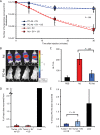Enhanced tumor uptake and penetration of virotherapy using polymer stealthing and focused ultrasound
- PMID: 24168971
- PMCID: PMC3833932
- DOI: 10.1093/jnci/djt305
Enhanced tumor uptake and penetration of virotherapy using polymer stealthing and focused ultrasound
Abstract
Background: Oncolytic viruses are among the most powerful and selective cancer therapeutics under development and are showing robust activity in clinical trials, particularly when administered directly into tumor nodules. However, their intravenous administration to treat metastatic disease has been stymied by unfavorable pharmacokinetics and inefficient accumulation in and penetration through tumors.
Methods: Adenovirus (Ad) was "stealthed" with a new N-(2-hydroxypropyl)methacrylamide polymer, and circulation kinetics were characterized in Balb/C SCID mice (n = 8 per group) bearing human ZR-75-1 xenograft tumors. Then, to noninvasively increase extravasation of the circulating polymer-coated Ad into the tumor, it was coinjected with gas microbubbles and the tumor was exposed to 0.5 MHz focused ultrasound at peak rarefactional pressure of 1.2 MPa. These ultrasound exposure conditions were designed to trigger inertial cavitation, an acoustic phenomenon that produces shock waves and can be remotely monitored in real-time. Groups were compared with Student t test or one-way analysis of variance with Tukey correction where groups were greater than two. All statistical tests were two-sided.
Results: Polymer-coating of Ad reduced hepatic sequestration, infection (>8000-fold; P < .001), and toxicity and improved circulation half-life (>50-fold; P = .001). Combination of polymer-coated Ad, gas bubbles, and focused ultrasound enhanced tumor infection >30-fold; (4 × 10(6) photons/sec/cm(2); standard deviation = 3 × 10(6) with ultrasound vs 1.3 × 10(5); standard deviation = 1 × 10(5) without ultrasound; P = .03) and penetration, enabling kill of cells more than 100 microns from the nearest blood vessel. This led to substantial and statistically significant retardation of tumor growth and increased survival.
Conclusions: Combining drug stealthing and ultrasound-induced cavitation may ultimately enhance the efficacy of a range of powerful therapeutics, thereby improving the treatment of metastatic cancer.
Figures




References
-
- Khuri FR, Nemunaitis J, Ganly I, et al. A controlled trial of intratumoral ONYX-015, a selectively-replicating adenovirus, in combination with cisplatin and 5-fluorouracil in patients with recurrent head and neck cancer. Nat Med. 2000;6(8):879–885 - PubMed
-
- Liu TC, Galanis E, Kirn D. Clinical trial results with oncolytic virotherapy: a century of promise, a decade of progress. Nat Clin Pract Oncol. 2007;4(2):101–117 - PubMed
-
- Peng Z, Yu Q, Bao L. The application of gene therapy in China. IDrugs. 2008;11(5):346–350 - PubMed
-
- Lyons M, Onion D, Green NK, et al. Adenovirus type 5 interactions with human blood cells may compromise systemic delivery. Mol Ther. 2006;14(1):118–128 - PubMed
Publication types
MeSH terms
Substances
Grants and funding
LinkOut - more resources
Full Text Sources
Other Literature Sources
Medical

